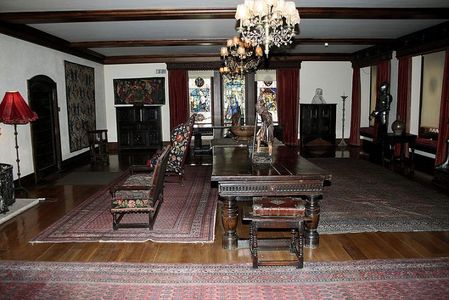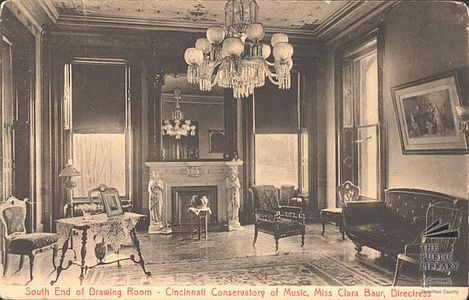Drawing room
A Drawing room (or drawing-room) is a room in a house where visitors may be entertained. The name is derived from the sixteenth-century terms "withdrawing room" and "withdrawing chamber," which remained in use through the seventeenth century, and made its first written appearance in 1642 (OED). In a large sixteenth- to early eighteenth-century English house, a withdrawing room was a room to which the owner of the house, his wife, or a distinguished guest who was occupying one of the main apartments in the house could "withdraw" for more privacy. It was often off the great chamber (or the great chamber's descendant, the stateroom or salon) and usually led to a formal, or "state" bedroom.
In eighteenth-century London, the Royal morning receptions that the French called levées were called "drawing rooms", with the sense originally that the privileged members of the court would gather in the drawing-room outside the king's bedroom, where he would make his first formal public appearance of the day.
- Wikipedia article: Levée_(ceremony) [Note 1]
During the American Civil War, in the White House of the Confederacy (Museum of the Confederacy) in Richmond, Virginia, the drawing-room was just off of the parlor where C.S.A. (Confederate States of America} President Jefferson Davis would greet his guests. At the conclusion of these greetings, the men would remain in the parlor to talk politics and the women would withdraw to the drawing-room for their own conversation. This was common practice in the affluent circles of the Southern United States.
Until the mid-twentieth century, after a dinner the ladies of a dinner party would withdraw to the drawing-room, leaving the gentlemen at table, where the cloth was removed. After an interval of conversation, the gentlemen would rejoin the ladies in the drawing-room.
The term drawing-room is not used as widely as it once was, and tends to be used in Britain only by those who also have other reception rooms, such as a morning room, a nineteenth-century designation for a sitting-room, often with east-facing exposure, suited for daytime calls, or the middle-class lounge, a late nineteenth-century designation for a room in which to relax; hence the drawing-room is the smartest room in the house, usually used by the adults of the family when entertaining. Though this term is still widely used in India and Pakistan, probably since the colonial days, in the larger urban houses of the cities where there are many rooms.
The American equivalent was the parlor, or as many would later call it, living room. In French usage, the room and the social gathering it contained are equally the salon.
Railroad usage
The term has also been applied to passenger trains, supplanting parlor car, to designate some of the most spacious and expensive private accommodations available onboard a sleeping car or private railroad car. In North America, it meant a room that slept three or more, with a private washroom. While Amtrak has retired cars built with drawing-rooms, they are currently still used by VIA Rail Canada, although the traditional nomenclature is seen as archaic and are officially sold as "triple bedrooms".
Drawing-room plays
The drawing-room, being a room in the house to entertain visitors, gave its name to drawing-room comedy, a genre of theatrical productions and motion pictures. Beginning with the early forms of drama, the drawing-room play has evolved to encompass comedy as well as to include the forms of dramatic monologue. The play format itself has also grown out of the traditional drawing room performance and back into main street theater and film. While the drawing-room itself has fallen out of favor, the play format has continued to provide a source of entertainment.
Drawing room comedy typically features wit and verbal banter among wealthy, leisured, genteel, upper-class characters. Drawing room comedy is also sometimes called the "comedy of manners." Oscar Wilde's The Importance of Being Earnest and several of the plays of Noel Coward are typical works of the genre. George Bernard Shaw's Heartbreak House adds an undercurrent of social criticism to the genre. Cary Grant appeared in a number of filmed drawing-room comedies. Ernst Lubitsch was especially known as a director of drawing-room comedies.
See also Gold Tea
Notes
- ↑ {Interesting article!)
Chat rooms • What links here • Copyright info • Contact information • Category:Root


